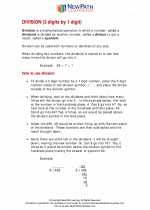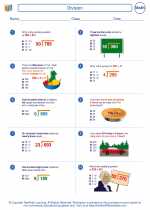Counting
Counting is the process of determining the number of elements in a set or group. It is a fundamental concept in mathematics and is used in various mathematical operations and problem-solving scenarios.
Counting Principles
There are several counting principles that are commonly used in mathematics:
- One-to-One Correspondence: This principle states that two sets have the same number of elements if there is a one-to-one correspondence between the elements of the two sets. For example, if we can pair each element of set A with a unique element of set B, then the two sets have the same number of elements.
- Counting by Multiplication: When there are multiple independent events or choices, the total number of outcomes can be found by multiplying the number of outcomes for each event. This is known as the multiplication principle of counting.
- Counting by Addition: When there are multiple mutually exclusive events or choices, the total number of outcomes can be found by adding the number of outcomes for each event. This is known as the addition principle of counting.
Types of Counting Problems
There are several types of counting problems that frequently appear in mathematics, including:
- Permutations: Permutations are arrangements of objects in a specific order. The number of permutations of n objects taken r at a time is denoted by nPr or P(n, r) and is given by n! / (n - r)!.
- Combinations: Combinations are selections of objects without considering the order. The number of combinations of n objects taken r at a time is denoted by nCr or C(n, r) and is given by n! / [r! * (n - r)!].
- Counting with Restrictions: Counting problems that involve certain restrictions or conditions, such as counting the number of ways to arrange objects subject to specific rules or limitations.
Study Guide for Counting
To master the concept of counting, it is important to practice various types of counting problems and familiarize yourself with the counting principles. Here are a few tips for studying counting:
- Practice solving permutation and combination problems to understand the difference between arrangements and selections.
- Work on counting problems with restrictions to develop problem-solving skills and logical reasoning.
- Use visual aids, such as diagrams or charts, to help organize information and visualize counting scenarios.
- Explore real-life applications of counting, such as in probability and statistics, to understand the practical significance of counting principles.
- Seek additional resources, such as textbooks, online tutorials, and practice exercises, to reinforce your understanding of counting.
By mastering the principles of counting and practicing various types of counting problems, you can develop a strong foundation in this fundamental mathematical concept.
.◂Math Worksheets and Study Guides Sixth Grade. Division
Study Guide Division
Division  Worksheet/Answer key
Worksheet/Answer key Division
Division  Worksheet/Answer key
Worksheet/Answer key Division
Division  Worksheet/Answer key
Worksheet/Answer key Division
Division 

 Worksheet/Answer key
Worksheet/Answer key
 Worksheet/Answer key
Worksheet/Answer key
 Worksheet/Answer key
Worksheet/Answer key

The resources above cover the following skills:
Connections to the Grade 6 Focal Points (NCTM)
Number and Operations: Students' work in dividing fractions shows them that they can express the result of dividing two whole numbers as a fraction (viewed as parts of a whole). Students then extend their work in grade 5 with division of whole numbers to give mixed number and decimal solutions to division problems with whole numbers. They recognize that ratio tables not only derive from rows in the multiplication table but also connect with equivalent fractions. Students distinguish multiplicative comparisons from additive comparisons.